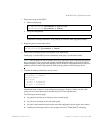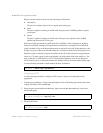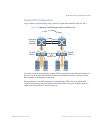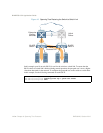
BMD00220, October 2010 109
CHAPTER 8
Spanning Tree Protocols
When multiple paths exist between two points on a network, Spanning Tree Protocol (STP), or one
of its enhanced variants, can prevent broadcast loops and ensure that the RackSwitch G8124
(G8124) uses only the most efficient network path.
This chapter covers the following topics:
“Spanning Tree Protocol Modes” on page 109
“Global STP Control” on page 110
“STP/PVST+ Mode” on page 111
“Rapid Spanning Tree Protocol” on page 124
“Per-VLAN Rapid Spanning Tree Groups” on page 126
“Multiple Spanning Tree Protocol” on page 127
“Port Type and Link Type” on page 131
Spanning Tree Protocol Modes
BLADEOS 6.5 supports the following STP modes:
Spanning Tree Protocol/Per-VLAN Spanning Tree Plus (STP/PVST+)
STP as defined in IEEE 802.1D (1998) allows devices to detect and eliminate logical loops in
a bridged or switched network. When multiple paths exist, STP configures the network so that
only the most efficient path is used. If that path fails, STP automatically configures the best
alternative active path on the network in order to sustain network operations.
BLADEOS STP/PVST+ supports multiple instances of Spanning Tree, allowing one Spanning
Tree Group (STG) per VLAN and is compatible with Cisco PVST+ mode.
See “STP/PVST+ Mode” on page 111 for details.


















